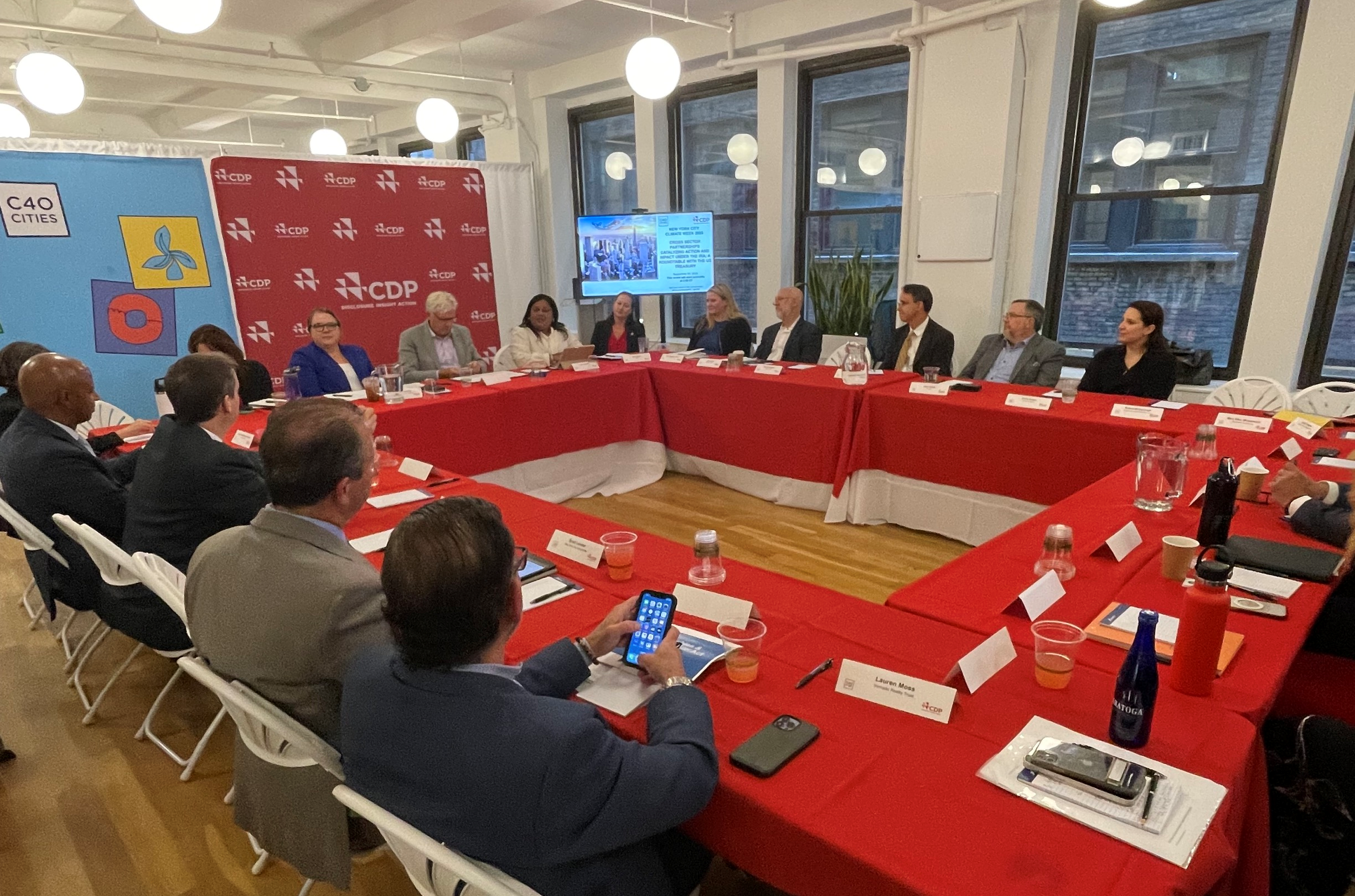
As the 78th United Nations General Assembly and New York Climate Week 2023 were in full swing, CDP and C40 convened more than 40 mayors, senior government leaders, financial institutions, non-profits and companies to discuss implementation of the Inflation Reduction Act (IRA) with Laurel Blatchford, the US Department of the Treasury’s Chief Implementation Officer for the IRA. The discussion provided critical insight into the opportunities for cross-sectoral partnerships created by the IRA, and identified operational challenges different actors are working to address to bring projects to fruition.
As the federal government’s most significant action ever on clean energy and climate mitigation, the IRA opens up significant opportunities for a new era of climate investment. The IRA includes more than US$369 billion, split between new direct spending, incentives for private investment, bonus incentives and tax credits. The IRA could provide much needed investment in school districts, cities, states and public authorities, as well as help to create quality jobs and achieve multiple equity, environmental and justice goals. Through the Elective Pay policy and Low-income Communities bonus credit, the IRA has opened critical clean energy project financing by making tax credits available to organizations and cities for the first time.
Leaders from the public, financial, industry and nonprofit sectors agreed that the potential for impact is enormous. Nonetheless, there are many ways different actors in the system must work together in novel ways to take full advantage. If implemented successfully, the IRA can increase social and economic benefits for historically marginalized communities, which are disproportionately impacted by climate change. To do so will require breaking down barriers between local governments, community development finance institutions, capital providers, businesses and community interests.
Key takeaways from the discussion:

- Projects are not one-size fits all: what works in one city or region may not be applicable to another, where demographic, climate, economic and societal realities can affect the types and scopes of projects. Participants noted that smaller cities in particular face numerous challenges in taking advantage of these funding opportunities including less capacity to identify eligible projects, lack of resources to prioritize and apply for grant funding and smaller, lower cost projects that may not reach funding thresholds – to name a few.
- Collaboration is key. Access to and implementation of IRA funding, especially the Elective Pay policy, is bringing together local governments, businesses and Community Development Finance Institutions (CDFIs) in new ways. Some participants had never considered convening the kinds of stakeholders who attended the forum, but realized how necessary this would be in activating these revolutionary tax incentives. To achieve progress, there exists a clear need to speak across sectors and define a common language.

- City leadership can be catalytic in convening, driving momentum and helping effectuate change. This could entail bringing together key players within cities who will drive the success of IRA implementation. Cities are looking for match partners (financial institutions or companies) that can help bridge funding gaps to finance all phases of project development and ensure projects can appropriately leverage IRA credits. In particular, participants noted how IRA credits could fund equitable housing programs and initiatives that target historically marginalized communities.
- This is an unprecedented time for a variety of financial actors that have previously had less of an explicit focus on climate. CDFIs and community lenders will play a pivotal role providing capital that will be at the center of many of these projects, help leverage additional capital and often best understand community and small business needs. Simultaneously, given the newly explicit focus on climate related investments, there will likely be a challenge of large-scale coordination and a topical learning curve that city climate leaders can help address.
- There needs to be an increased focus on adaptation and resilience. Much of the IRA and specifically the Greenhouse Gas Reduction Fund opportunities are mitigation related, while there are immense opportunities to invest in resilience and further focus on a more holistic approach to the wide-scale infrastructure investments that will take place in the coming years.

- A shift is underway in the financial sector. While banks are increasingly looking to underwrite long-term adaptation and resiliency initiatives, an ever-wider spectrum of investors that historically viewed projects purely through the lens of payback periods and positive net present value are now being activated by the IRA to develop investment strategies that prioritize economic development, community resilience and energy transition along with value creation. Both banks and investors also view the IRA as a way to prioritize their just transition agenda, helping maximize job creation and workforce development through finance that transitions us into a cleaner and fairer economy.
- Companies can also advance implementation under the IRA by identifying clean energy projects in strategic areas of operation, aligning with local municipalities while benefitting from the newly created tax credit transfer market for the private sector.
- A skilled workforce is key. Labor unions and local contractors will play an outsized role in making sure people are in place who can advance new technologies and that companies can access project credits. For more information check out recent guidance from the White House on Equitable Workforce Development.
The IRA is game-changing, yet the discussion also highlighted how many entities are not fully aware of the tax credits, how to apply them nor how to speak the same language with key stakeholders. There is concern that certain aspects are proving difficult to navigate, including domestic content provisions, startup capital and projects being shovel-ready and shovel-worthy as well as financeable. The US Treasury is working to bridge some of these gaps with guidance and resources, as well as engaging in multiple forums with key stakeholders.
The US Treasury and the IRS are building an ecosystem through these tax credits that will take time, juxtaposed against the urgency of climate risk horizons. Ultimately, effectively rolling out the IRA will require multi-stakeholder engagement and feedback, allowing cities and communities to drive solutions that meet their respective climate related challenges.
More discussions like the one hosted by C40 and CDP during Climate Week at the local, state and jurisdictional levels are essential going forward. To follow future discussions please sign up for the CDP newsletter here.

